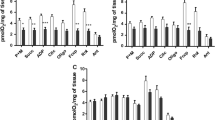Abstract
Cysticercoids as well as 6-, 10-, and 14-day Hymenolepis diminuta were evaluated in terms of enzymatic activities related to phosphoenolpyruvate (PEP) utilization and mitochondrial succinate accumulation. The data obtained support a transition toward anaerobic electron-transport-dependent succinate accumulation, characteristic of adult H. diminuta, with development from cysticercoid to adult. This transition was reflected most prominently in the increasing activities of PEP carboxykinase (PEPCK), malate dehydrogenase, NADPH → NAD+ transhydrogenase, and fumarate reductase. Developmental increases in PEPCK/pyruvate kinase (PK), fumarate reductase (FR)/NADH oxidase (NO), and FR/succinate dehydrogenase (SDH) activity ratios were also apparent. Evaluations of “egg-free” immature, mature, and pregravid-gravid segments of adult H. diminuta revealed that in general the greater levels of activity were associated with the immature and mature segments. Whereas FR/NO and FR/SDH ratios remained relatively constant in segment comparisons, the greatest PEPCK/PK ratio was associated with the pregravid-gravid segment.
Similar content being viewed by others
Author information
Authors and Affiliations
Additional information
Received: 2 December 1997 / Accepted: 5 June 1998
Rights and permissions
About this article
Cite this article
Fioravanti, C., Walker, D. & Sandhu, P. Metabolic transition in the development of Hymenolepis diminuta (Cestoda). Parasitol Res 84, 777–782 (1998). https://doi.org/10.1007/s004360050487
Issue Date:
DOI: https://doi.org/10.1007/s004360050487




